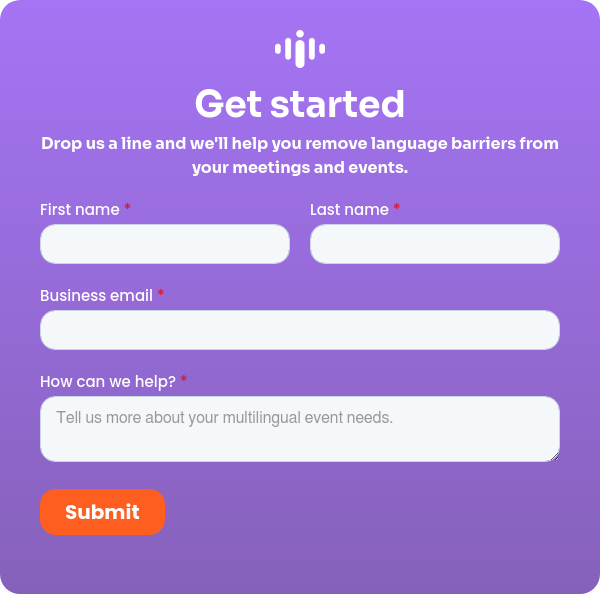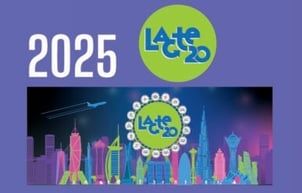With the rapid advancements in AI technology, real-time translation of meetings or event speeches is now possible through AI-powered speech translation solutions. This is a domain that was once exclusively occupied by simultaneous interpreters, leading to the question: what sets the two apart?
But first, let's explore the similarities between simultaneous interpreters and AI speech translation solutions. Both interpreters and AI share the remarkable ability to provide instantaneous translation of speech from one language to another, effectively bridging communication gaps during meetings, conferences, or live events and ensuring understanding of what is being communicated.
In a rush? Side-by-side comparison infographic at the bottom of this article.
Different approaches to translation accuracy
This may well be the biggest difference of all: Interpreters interpret and currently, AI translates.
Interpreters possess a keen attention to detail when it comes to accuracy, with the ultimate goal of conveying the essential message as precisely as possible to the audience. They use various techniques like summarising and paraphrasing to convey the message's meaning as accurately as possible. Interpreters must strike a delicate balance between accuracy and practicality, carefully navigating the terrain of conveying the essence of a message while still maintaining its true meaning.
Unlike interpreters who may summarise or paraphrase the message to convey its essential meaning, AI speech translation solutions take a verbatim approach to ensure no information is lost, even if the speaker talks at a rapid pace. This approach can offer the advantage of preserving the exact words used by the speaker, which can be particularly important in legal or medical contexts where precise terminology is critical. However, this can also result in a less natural-sounding translation that may not capture the speaker's intended tone or style, which could be important in more casual or creative settings. Nonetheless, AI technology is rapidly advancing, and we can expect to see more sophisticated approaches to translation in the near future.
Consistency in quality
Consistency in quality is another factor that distinguishes interpreters from AI speech translators. While interpreters' skills, experience, and topic expertise may vary, AI solutions provide general consistency in quality, although quality can still fluctuate depending on language combinations, topic areas, engines used, and terminology used.
Dealing with cultural subtleties
Linguists are cultural and language experts. They have a deep understanding of the nuances of language, including the subtle differences in tone, humour, and sarcasm. They can pick up on the underlying meaning of a message, as well as non-verbal cues, which is difficult to replicate with AI.
While AI speech translation solutions are getting better at understanding language, they still struggle with the complexities of humour, irony or non-verbal cues. Jokes, puns, sarcasm, irony, and wordplay can be lost in translation. This is because AI is focused on the literal meaning of the words, rather than the underlying message and it cannot pick up on the tone or inflexion of the speaker's voice either, which can be crucial to understanding the intended meaning.
Performance over time
Interpretation is a challenging profession that demands intense focus and cognitive agility. Simultaneous interpreters must listen, process, and translate speech in real time, which is mentally taxing. To alleviate this pressure, interpreters often work in pairs and alternate every 15-30 minutes. During full-day assignments, maintaining their performance levels can be quite a challenge and fatigue may impact performance over time.
Conversely, AI is not faced with the same challenge and will deliver consistent performance over time.
Dealing with accents and dialects
Accents and dialects can pose challenges for interpreters if they have no previous experience with them. However, most professional interpreters are generally trained to handle a variety of accents and dialects, and they can pick up on subtle differences in pronunciation.
On the other hand, AI speech translation solutions rely on machine learning algorithms that are trained on large datasets of audio and text and these algorithms are designed to handle different accents and dialects.
Aside from understanding accents and dialects, what's paramount for successful performance for both interpreters and AI, is the quality of the sound. Clear audio ensures that interpreters can accurately hear and interpret the speaker's words, while AI speech translation solutions can correctly transcribe and translate them. Background noise, poor microphone quality, or low volume can hinder both human and AI speech translation, causing errors and inaccuracies in the final output.
Both need to be prepared for the assignment
To achieve successful real-time translation, both human interpreters and AI speech translation solutions require adequate preparation beforehand. Interpreters need to be provided with necessary information about the event, including the topics to be discussed, the speakers, and any specific terminology that may be used. They also need to have access to relevant materials such as presentations and documents.
Similarly, certain providers of AI speech translation optimise the AI engine output further. In order to ensure event-specific terminologies such as speaker names, brand or product names, or unique industry terms don't get missed, the engines can be customised through glossary features to accurately capture these terms.
Language coverage and availability
Although AI speech translation solutions can currently support a wide range of languages with impressive accuracy, their language coverage is limited to those with high volumes of available training data. As AI technology continues to improve, more languages will be added to its repertoire.
For languages with lower volumes of available data, dialects, and oral languages, professional interpreters remain essential. One of the advantages of AI, however, is its availability and scalability, which can support multiple events simultaneously. This can be especially helpful for event planners who may struggle to find suitable interpreters for a specific language combination with short notice.
Key considerations for buyers of simultaneous translation services
In conclusion, both simultaneous interpreters and AI speech translation solutions have their unique strengths and limitations and they can complement each other.
Interpreters have the unique ability to adapt their rendition of the speech to the cultural context and non-verbal cues. Meanwhile, AI never gets tired and can provide complete and accurate translation with consistency in quality at a relatively low-cost point.
This provides event planners with the freedom to choose the approach that best fits their unique challenges and goals. More than that, event planners can combine both approaches to scale up their language offerings. Some languages can be supported through simultaneous interpretation, while others are supported through AI.
Some of the key considerations event planners should plan for when deciding on which approach they want to opt for include:
- What are the required languages? Is it possible to source interpreters of these languages? Are these languages supported by AI?
- What is the budget available for interpretation?
- How deep is the level of cultural nuance, emotion and non-verbal language that needs to be reflected in the translation?
Comparison overview
.jpg?width=830&height=1174&name=comparison%20infographics%20(1).jpg)





 More download links
More download links



